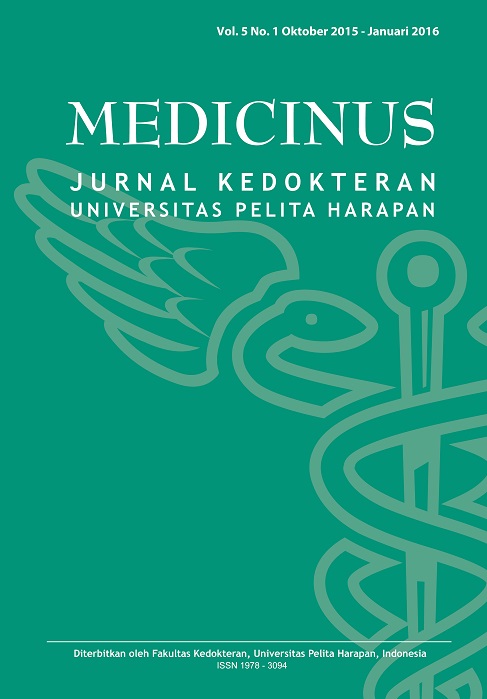A Planned Cesarean Section-Hysterectomy For Placenta Previa Totalis Percreta In Patient With History Of Two Cesarean Sections
DOI:
https://doi.org/10.19166/med.v5i1.1176Abstract
The presence of placenta previa may be associated with placenta accreta[1]. Maternal and fetal morbidity and mortality from placenta previa accreta are considerable and are associated with high demands on health resources. With the rising incidence of caesarean sections combined with increasing maternal age, the number of cases of placenta praevia and its complications, including placenta accreta, will continue to increase[2]. Here, we present a case of placenta previa totalis percreta in previous cesarean section twice. In this case, patient with placenta previa totalis-percreta we diagnosed and prepared proper management with the involvement of multidisciplinary team. We reduced blood loss by performing total abdominal hysterectomy immediately after delivered the baby and the postoperative course was uneventful.
Keywords: Cesarean Section-Hysterectomy, placenta accreta, placenta percreta, placenta previa
References
Cunningham FG, Gant NF, Leveno KJ, Gilstrap LC, Houth JC, Wenstrom KD. William’s Obstetric.Obstetrical Hemorrhage, 24th ed. London: McGrawHill, 2014
RCOG “Placenta Praevia, Placenta Praevia Accreta and Vasa Praevia: Diagnosis and Management: Green-top Guideline No. 27, January 2011
ACOG. “Placenta accreta”. Committee Opinion No. 529. American College of Obstetricians and Gynecologists. Obstet Gynecology 2012;120:207-11.
A. Johnston, S. Paterson-Brown, “Placenta Praevia, Placenta Praevia Accreta and Vasa Praevia: Diagnosis and Management”. Royal College of Gynecology, Green-top Guideline No. 27 p.1-26
Poggi SBH, Kapernick PS. Postpartum hemorrhage and abnormal puerperium. In: DeCherney AH, Nathan L, editors. Current Diagnosis and Treatm ent Obstetrics and Gynecology. 10th ed. New York: McGraw-Hill Medical; 2007.
Abbas F, Talati J, Wasti S, Akram S, Ghaffar S, Qureshi RJ Urol. 2000 Oct; 164(4):1270-[PubMed] [Ref list]
M. Maher, A. Abdelaziz, M. Bazeed. “Diagnostic accuracy of ultrasound and MRI in the prenatal diagnosis of placenta accreta.” Acta Obstet Gynecol Scand. 2013 Sep;92(9):1017-22
C. Comstock, J. Love Jr, R. Bronsteen, W. Lee, I. Vettraino, R. Huang, R. Lorenz. “Sonographic detection of placenta accreta in the second and third trimesters of pregnancy.” American Journal of Obstetrics and Gynecology. 2004 Apr;190(4):1135-40. PubMed PMID: 15118654. http://dx.doi.org/10.1016/j.ajog.2003.11. 024
R. Resnick, “Management of the Morbidly adherent placenta (Placenta Acreta, Increta, and Percreta). Up-to-date. Last updated: May 12, 2015.
Downloads
Published
How to Cite
Issue
Section
License
Copyright (c) 2018 Julita Nainggolan

This work is licensed under a Creative Commons Attribution-ShareAlike 4.0 International License.
Authors who publish with this journal agree to the following terms:
1) Authors retain copyright and grant the journal right of first publication with the work simultaneously licensed under a Creative Commons Attribution License (CC-BY-SA 4.0) that allows others to share the work with an acknowledgement of the work's authorship and initial publication in this journal.
2) Authors are able to enter into separate, additional contractual arrangements for the non-exclusive distribution of the journal's published version of the work (e.g., post it to an institutional repository or publish it in a book), with an acknowledgement of its initial publication in this journal.
3) Authors are permitted and encouraged to post their work online (e.g., in institutional repositories or on their website). The final published PDF should be used and bibliographic details that credit the publication in this journal should be included.





